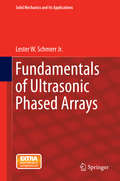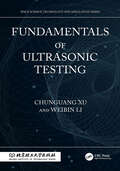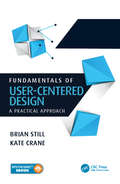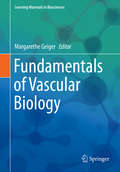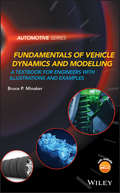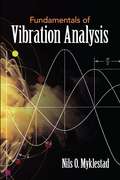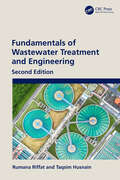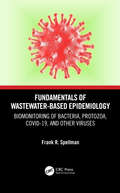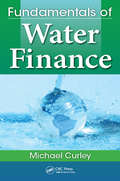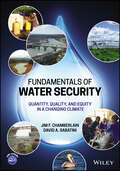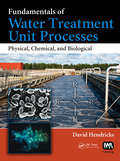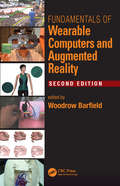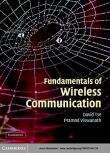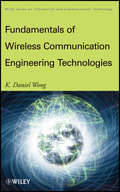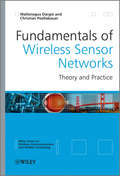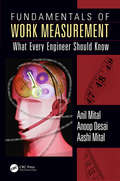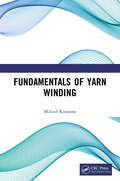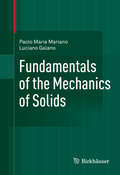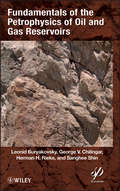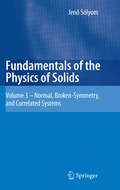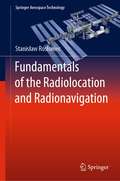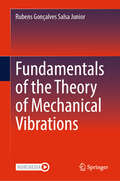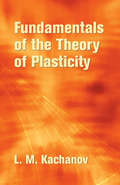- Table View
- List View
Fundamentals of Ultra-Thin-Body MOSFETs and FinFETs
by Jerry G. Fossum Vishal P. TrivediUnderstand the theory, design and applications of the two principal candidates for the next mainstream semiconductor-industry device with this concise and clear guide to FD/UTB transistors. - Describes FD/SOI MOSFETs and 3-D FinFETs in detail - Covers short-channel effects, quantum-mechanical effects, applications of UTB devices to floating-body DRAM and conventional SRAM - Provides design criteria for nanoscale FinFET and nanoscale thin- and thick-BOX planar FD/SOI MOSFET to help reduce technology development time - Projects potential nanoscale UTB CMOS performances - Contains end-of-chapter exercises. For professional engineers in the CMOS IC field who need to know about optimal non-classical device design and integration, this is a must-have resource.
Fundamentals of Ultrasonic Phased Arrays
by Lester W. Schmerr Jr.This book describes in detail the physical and mathematical foundations of ultrasonic phased array measurements The book uses linear systems theory to develop a comprehensive model of the signals and images that can be formed with phased arrays. Engineers working in the field of ultrasonic nondestructive evaluation (NDE) will find in this approach a wealth of information on how to design, optimize and interpret ultrasonic inspections with phased arrays. The fundamentals and models described in the book will also be of significant interest to other fields, including the medical ultrasound and seismology communities. A unique feature of this book is that it presents a unified theory of imaging with phased arrays that shows how common imaging methods such as the synthetic aperture focusing technique (SAFT), the total focusing method (TFM), and the physical optics far field inverse scattering (POFFIS) imaging method are all simplified versions of more fundamental and quantitative imaging approaches, called imaging measurement models. To enhance learning, this book first describes the fundamentals of phased array systems using 2-D models, so that the complex 3-D cases normally found in practice can be more easily understood In addition to giving a detailed discussion of phased array systems, Fundamentals of Ultrasonic Phased Arrays also provides MATLAB® functions and scripts, allowing the reader to conduct simulations of ultrasonic phased array transducers and phased array systems with the latest modeling technology.
Fundamentals of Ultrasonic Testing (Space Science, Technology and Application Series)
by Weibin Li Chunguang XuFocusing on the theory and state-of-the-art technologies of ultrasonic testing (UT), this book examines ultrasonic propagation in solids and its detection applications, and explores the intersection of UT technology with various fields of electromagnetics, optics and physics.UT is one of the most widely used nondestructive testing techniques due to its high performance in terms of detection efficiency and safety. The rapid development of modern industrial products and technologies has created a new challenge and demand for ultrasonic nondestructive testing technology. This book introduces the fundamentals of UT, including sound wave and sound field, interface wave theory and liquid-solid coupled sound field. It then discusses various types of UT methods, ranging from the critically refracted longitudinal wave method to ultrasonic surface wave and ultrasonic guided wave detection methods. Some newly developed UT techniques are also discussed, including phased-array UT, high-frequency UT and non-contact UT.This title will appeal to engineering students and technicians in the field of ultrasonic nondestructive testing.
Fundamentals of Underwater Acoustics
by Orlando Camargo RodríguezThis textbook on Underwater Acoustics has a structure that is more organic than logical. It thereby unifies diverse areas of research, including topics of signal processing, the sonar equation, sources and receivers, scattering and reverberation, wave propagation, propagation models, and inverse problems. It also provides code fragments written in Python which complement the discussion. This is a book written for both beginners and specialists, as well as for biologists, oceanographers, computer engineers, physicists, and mathematicians, and for civilian and naval personnel who are looking for a introductory overview of the topic.
Fundamentals of User-Centered Design: A Practical Approach
by Brian Still Kate CraneThere has been some solid work done in the area of User-Centered Design (UCD) over the last few years. What’s been missing is an in-depth, comprehensive textbook that connects UCD to usability and User Experience (UX) principles and practices. This new textbook discusses a theoretical framework in relation to other design theories. It provides a repeatable, practical process for implementation, offering numerous examples, methods, and case studies for support, and it emphasizes best practices in specific environments, including mobile and web applications, print products, as well as hardware.
Fundamentals of Vascular Biology (Learning Materials in Biosciences)
by Margarethe GeigerThis well-structured textbook offers essential knowledge on the vascular system. The reader will learn the properties, basic cellular mechanisms and development of the different parts of the vascular system (including the heart), gain knowledge on vascular and related diseases, and will be made familiar with common and most current methods and techniques applied to analyze the vascular system in patients, in animal models, and ex vivo. This book is based on a PhD Course for students from various bioscientific backgrounds given at the Medical University of Vienna, and it will be a valuable resource for Master´s Students in vascular biology and biomedicine in general and a helpful tool for young researchers world-wide wishing to gain or refresh their knowledge in this field.
Fundamentals of Vehicle Dynamics and Modelling: A Textbook for Engineers With Illustrations and Examples (Automotive Series)
by Bruce P. MinakerAn introduction to vehicle dynamics and the fundamentals of mathematical modeling Fundamentals of Vehicle Dynamics and Modeling is a student-focused textbook providing an introduction to vehicle dynamics, and covers the fundamentals of vehicle model development. It illustrates the process for construction of a mathematical model through the application of the equations of motion. The text describes techniques for solution of the model, and demonstrates how to conduct an analysis and interpret the results. A significant portion of the book is devoted to the classical linear dynamic models, and provides a foundation for understanding and predicting vehicle behaviour as a consequence of the design parameters. Modeling the pneumatic tire is also covered, along with methods for solving the suspension kinematics problem, and prediction of acceleration and braking performance. The book introduces the concept of multibody dynamics as applied to vehicles and provides insight into how large and high fidelity models can be constructed. It includes the development of a method suitable for computer implementation, which can automatically generate and solve the linear equations of motion for large complex models. Key features: ● Accompanied by a website hosting MATLAB® code. ● Supported by the Global Education Delivery channels. Fundamentals of Vehicle Dynamics and Modeling is an ideal textbook for senior undergraduate and graduate courses on vehicle dynamics.
Fundamentals of Vibration Analysis (Dover Books on Engineering)
by Nils O. MyklestadGeared toward advanced undergraduate and graduate students in engineering, this concise textbook discusses vibration problems, dealing with systems of one and more than one degree of freedom. Numerous examples and problems assist students in mastering the material and demonstrate the applicability of the methods of analysis used in the text. Starting with an overview of the fundamentals, the treatment examines undamped vibrations of single-degree-of-freedom systems, vibrations of single-degree-of-freedom systems with viscous damping, systems of one degree of freedom with nonviscous damping, and undamped vibrations of systems with more than one degree of freedom. Additional topics include application of generalized coordinates, damped vibrations of systems with more than one degree of freedom, and tabular methods for finding natural frequencies. Numerous figures illuminate the text, which concludes with a substantial section of answers to the problems.
Fundamentals of Wastewater Treatment and Engineering
by Rumana Riffat Taqsim HusnainThe 2nd edition of Fundamentals of Wastewater Treatment and Design introduces readers to the fundamental concepts of wastewater treatment, followed by engineering design of unit processes for sustainable treatment of municipal wastewater and resource recovery. It has been completely updated with new chapters to reflect current advances in design, resource recovery practices and research. Another highlight is the addition of the last chapter, which provides a culminating design experience of both urban and rural wastewater treatment systems. Filling the need for a textbook focused on wastewater, it covers history, current practices, emerging concerns, future directions and pertinent regulations that have shaped the objectives of this important area of engineering. Basic principles of reaction kinetics, reactor design and environmental microbiology are introduced along with natural purification processes. It also details the design of unit processes for primary, secondary and advanced treatment, as well as solids processing and removal. Recovery of water, energy and nutrients are explained with the help of process concepts and design applications. This textbook is designed for undergraduate and graduate students who have some knowledge of environmental chemistry and fluid mechanics. Professionals in the wastewater industry will also find this a handy reference.
Fundamentals of Wastewater-Based Epidemiology: Biomonitoring of Bacteria, Protozoa, COVID-19, and Other Viruses
by Frank R. SpellmanIt is common practice to evaluate wastewater to understand drug consumption, from antibiotics to illegal narcotics, and even to analyze dietary habits and trends. Evaluating contaminants in wastewater enables researchers, environmental scientists, and water quality experts to gain valuable information and data. Wastewater-based epidemiology is an emerging science that has proven to be a cost- and time-effective biomonitoring tool. This book provides a roadmap for detecting wastewater-borne pathogenic contaminants such as viruses, bacteria, fungi, and others. It provides a basic, fundamental discussion of how sampling and monitoring of wastewater using epidemiological concepts and practices can aid in determining the presence of the COVID-19 virus in a community, for example, and may help predict future outbreaks. Features • Offers a unique discussion of the detection of bacteria, fungi, and COVID-19, and other viruses in wastewater • Presents the fundamentals of wastewater chemistry and microbiology • Explains biomonitoring, sampling, testing, and health surveillance in a practical manner Fundamentals of Wastewater-Based Epidemiology: Biomonitoring of Bacteria, Fungi, COVID-19, and Other Viruses is an invaluable resource to a wide array of readers with varying interests and backgrounds in water science and public health.
Fundamentals of Water Finance
by Michael CurleyThis book addresses ways to provide the highest quality water services at the lowest possible cost, and examines the major finance issues that system managers face. It deals with grants, loans, municipal bonds, tariffs/rates and subsidies, as well as the major government finance programs offered by the Department of Agriculture and the EPA. It also provides managers with the tools to devise innovative financial strategies to make their systems much more efficient. This fully revised edition presents an easy-to-read guide for understanding the myriad options available for financing water and wastewater projects and how to evaluate the most appropriate options.
Fundamentals of Water Security: Quantity, Quality, and Equity in a Changing Climate
by Jim F. Chamberlain David A. SabatiniFUNDAMENTALS OF WATER SECURITY Understand How to Manage Water Resources to Equitably Meet Both Human and Ecological Needs Burgeoning populations and the ever-higher standards of living for those in emerging countries increase the demand on our water resources. What is not increasing, however, is the supply of water and the total amount of water in earth’s biosphere—water that is integral to all standards of living. Fundamentals of Water Security provides a foundation for understanding and managing the quantity-quality-equity nexus of water security in a changing climate. In a broad sense, this volume explores solutions to water security challenges around the world. It is richly illustrated and pedagogically packed with up-to-date information. The text contains chapter learning objectives, foundation sections reviewing quantitative skills, case studies, and vignettes of people who have made important contributions to water security. To further aid comprehension, end-of-chapter problems are included—both qualitative and quantitative, with solutions available to instructors. Finally, extensive references feature books, journal articles, and government and NGO reports. Sample topics discussed include: How the study of water resources has evolved from a focus on physical availability to include social factors and governance How water security affects multiple disciplines across environmental science and engineering, hydrology, geography, water resources, atmospheric science, chemistry, biology, health science, and social and political science fields How to achieve a sufficient quantity and quality of water to equitably meet both immediate and long-term human and ecological needs Analysis of water security in an integrated manner by underscoring the complex interactions between water quantity, water quality, and society Students taking courses on hydrology, water security, and/or water resource management, along with scientists working in fields where water security is a factor will be able to use Fundamentals of Water Security as a comprehensive textbook to understand and achieve water security.
Fundamentals of Water Treatment Unit Processes: Physical, Chemical, and Biological
by David HendricksCarefully designed to balance coverage of theoretical and practical principles, Fundamentals of Water Treatment Unit Processes delineates the principles that support practice, using the unit processes approach as the organizing concept. The author covers principles common to any kind of water treatment, for example, drinking water, municipal wastew
Fundamentals of Wearable Computers and Augmented Reality
by Woodrow BarfieldData will not help you if you can't see it where you need it. Or can't collect it where you need it. Upon these principles, wearable technology was born. And although smart watches and fitness trackers have become almost ubiquitous, with in-body sensors on the horizon, the future applications of wearable computers hold so much more. A trusted refer
Fundamentals of Wireless Communication
by David Tse Pramod ViswanathThe past decade has seen many advances in physical layer wireless communication theory and their implementation in wireless systems. This textbook takes a unified view of the fundamentals of wireless communication and explains the web of concepts underpinning these advances at a level accessible to an audience with a basic background in probability and digital communication. Topics covered include MIMO (multi-input, multi-output) communication, space-time coding, opportunistic communication, OFDM and CDMA. The concepts are illustrated using many examples from real wireless systems such as GSM, IS-95 (CDMA), IS-856 (1 x EV-DO), Flash OFDM and UWB (ultra-wideband). Particular emphasis is placed on the interplay between concepts and their implementation in real systems. An abundant supply of exercises and figures reinforce the material in the text. This book is intended for use on graduate courses in electrical and computer engineering and will also be of great interest to practising engineers.
Fundamentals of Wireless Communication Engineering Technologies
by K. Daniel WongA broad introduction to the fundamentals of wireless communication engineering technologies Covering both theory and practical topics, Fundamentals of Wireless Communication Engineering Technologies offers a sound survey of the major industry-relevant aspects of wireless communication engineering technologies. Divided into four main sections, the book examines RF, antennas, and propagation; wireless access technologies; network and service architectures; and other topics, such as network management and security, policies and regulations, and facilities infrastructure. Helpful cross-references are placed throughout the text, offering additional information where needed. The book provides: Coverage that is closely aligned to the IEEE's Wireless Communication Engineering Technologies (WCET) certification program syllabus, reflecting the author's direct involvement in the development of the program A special emphasis on wireless cellular and wireless LAN systems An excellent foundation for expanding existing knowledge in the wireless field by covering industry-relevant aspects of wireless communication Information on how common theories are applied in real-world wireless systems With a holistic and well-organized overview of wireless communications, Fundamentals of Wireless Communication Engineering Technologies is an invaluable resource for anyone interested in taking the WCET exam, as well as practicing engineers, professors, and students seeking to increase their knowledge of wireless communication engineering technologies.
Fundamentals of Wireless Sensor Networks
by Waltenegus Dargie Christian PoellabauerIn this book, the authors describe the fundamental concepts and practical aspects of wireless sensor networks. The book provides a comprehensive view to this rapidly evolving field, including its many novel applications, ranging from protecting civil infrastructure to pervasive health monitoring. Using detailed examples and illustrations, this book provides an inside track on the current state of the technology. The book is divided into three parts. In Part I, several node architectures, applications and operating systems are discussed. In Part II, the basic architectural frameworks, including the key building blocks required for constructing large-scale, energy-efficient sensor networks are presented. In Part III, the challenges and approaches pertaining to local and global management strategies are presented - this includes topics on power management, sensor node localization, time synchronization, and security. At the end of each chapter, the authors provide practical exercises to help students strengthen their grip on the subject. There are more than 200 exercises altogether.Key Features:Offers a comprehensive introduction to the theoretical and practical concepts pertaining to wireless sensor networks Explains the constraints and challenges of wireless sensor network design; and discusses the most promising solutions Provides an in-depth treatment of the most critical technologies for sensor network communications, power management, security, and programming Reviews the latest research results in sensor network design, and demonstrates how the individual components fit together to build complex sensing systems for a variety of application scenarios Includes an accompanying website containing solutions to exercises (http://www.wiley.com/go/dargie_fundamentals) This book serves as an introductory text to the field of wireless sensor networks at both graduate and advanced undergraduate level, but it will also appeal to researchers and practitioners wishing to learn about sensor network technologies and their application areas, including environmental monitoring, protection of civil infrastructure, health care, precision agriculture, traffic control, and homeland security.
Fundamentals of Work Measurement: What Every Engineer Should Know
by Anil Mital Anoop Desai Aashi MitalThis book will provide a quick reference on Work Measurement. While the nature of the work may differ, measuring work is fundamental to any industrial or service activity. It’s needed to determine such things as the amount a person should be paid, how much time should it take to perform an activity, what is an acceptable days’ work, or how any two or more methods or designs compare. This book provides non-industrial engineers with the why and the how work is measured in order to perform their jobs.
Fundamentals of Yarn Winding
by Milind KoranneThis book focuses on the fundamental aspects of yarn winding from a broader perspective. Supplemented with self-explanatory labelled diagrams and photographs, the subject matter of this book includes – Principles of winding systems Winding package parameters Yarn tension during winding Package driving and yarn traversing Winding package faults and remedies Print edition not for sale in South Asia (India, Sri Lanka, Nepal, Bangladesh, Pakistan and Bhutan)
Fundamentals of the Mechanics of Solids
by Paolo Maria Mariano Luciano GalanoThis distinctive textbook aims to introduce readers to the basic structures of the mechanics of deformable bodies, with a special emphasis on the description of the elastic behavior of simple materials and structures composed by elastic beams. The authors take a deductive rather than inductive approach and start from a few first, foundational principles. A wide selection of exercises, many with hints and solutions, are provided throughout and organized in a way that will allow readers to form a link between abstract mathematical concepts and real-world applications. The text begins with the definition of bodies and deformations, keeping the kinematics of rigid bodies as a special case; the authors also distinguish between material and spatial metrics, defining each one in the pertinent space. Subsequent chapters cover observers and classes of possible changes; forces, torques, and related balances, which are derived from the invariance under classical changes in observers of the power of the external actions over a body, rather than postulated a priori; constitutive structures; variational principles in linear elasticity; the de Saint-Venant problem; yield criteria and a discussion of their role in the representation of material behavi∨ and an overview of some bifurcation phenomena, focusing on the Euler rod. An appendix on tensor algebra and tensor calculus is included for readers who need a brief refresher on these topics. Fundamentals of the Mechanics of Solids is primarily intended for graduate and advanced undergraduate students in various fields of engineering and applied mathematics. Prerequisites include basic courses in calculus, mathematical analysis, and classical mechanics.
Fundamentals of the Petrophysics of Oil and Gas Reservoirs
by Leonid Buryakovsky George V. Chilingar Herman H. Rieke Sanghee ShinWritten by some of the world's most renowned petroleum and environmental engineers, Petrophysics: The Fundamentals of Oil and Gas Revervoirs is the first book to offer the practicing engineer and engineering student these new cutting-edge techniques for prediction and forecasting in petroleum engineering and environmental management.
Fundamentals of the Physics of Solids
by Jenö SólyomThis book is the third of a three-volume series written by the same author. It aims to deliver a comprehensive and self-contained account of the fundamentals of the physics of solids. In the presentation of the properties and experimentally observed phenomena together with the basic concepts and theoretical methods, it goes far beyond most classic texts. The essential features of various experimental techniques are also explained. This volume is devoted mostly to the discussion of the effects of electron--electron interaction beyond the one-electron approximation. The density-functional theory is introduced to account for correlation effects. The response to external perturbations is discussed in the framework of linear response theory. Landau's Fermi-liquid theory is followed by the theory of Luttinger liquids. The subsequent chapters are devoted to electronic phases with broken symmetry: to itinerant magnetism, to spin- and charge-density waves and their realizations in quasi-one-dimensional materials, as well as to the microscopic theory of superconductivity. An overview is given of the physics of strongly correlated systems. The last chapter covers selected problems in the physics of disordered systems.
Fundamentals of the Radiolocation and Radionavigation (Springer Aerospace Technology)
by Stanisław RosłoniecThe book presents principles of operation of radar and radionavigation systems. The group of radar systems includes: primary and secondary radiolocations, bistatic and multistatic systems. They are illustrated with relevant examples of calculation and applications. The issues of increasing the range of the radar systems are presented together with the matched filtering of the used signals. Other discussed issues are methods for eliminating interfering signals and researching methods of 3D space. Various methods of the monopulse radiolocation are presented in Chapter 12. In Chapters 13–18 terrestrial and satellite radionavigation systems are under discussion. The terrestrial systems are: Loran C, Decca Navigator and Omega. The TRANSIT is an example of a hyperbolic satellite system. The stadiometric systems GPS, GLONASS, GALILEO, BeiDou, IRNSS and QZSS are discussed together with differential systems augmentating of them. The ILS, MLS and TLS supporting the landing of aircrafts are discussed in Chapter 17. The prospects for replacing of them with satellite systems augmentated by appropriate reference ground-based stations (GBAS) are also analyzed. Various beacons and ranging devices used in aviation are described in the Chapter 18. This book is intended primarily for students and engineers interested in radar, radionavigation and aerospace engineering.
Fundamentals of the Theory of Mechanical Vibrations
by Rubens Gonçalves Salsa JuniorThis book presents the fundamental concepts of modeling and analysis of vibrations in mechanical systems with one or more degrees of freedom. The presentation of classic topics is enriched by discussions on equilibrium, stability, and the linearization of the equations of motion. Practical examples throughout the text illustrate the applicability of the theory and explore the physics behind the equations. This book includes various Matlab codes, which allow readers to modify parameters and investigate the behavior of a wide range of mechanical systems. Furthermore, it is demonstrated how some of the mechanical systems studied can be constructed using ordinary materials, enabling readers to compare the theoretical results predicted by the mathematical models with the actual observed behavior.
Fundamentals of the Theory of Plasticity (Dover Civil And Mechanical Engineering Ser.)
by L. M. KachanovBased on the author's series of lectures at the Mechanics-Mathematics Faculty of the University of Leningrad, this text is primarily concerned with the plastic deformation of metals at normal temperatures, as applied to the strength of machines and structures. Its focus on delivering a simple presentation of the basic equations of plasticity theory encompasses the best-developed methods for solving the equations; it also considers problems associated with the special nature of plastic state and the most important engineering applications of plasticity theory.This volume traces the main trends in the theory's development, assuming readers' familiarity with the fundamentals of strength of materials and elasticity theory. Advanced topics are marked with an asterisk and can be omitted on a first reading. Intended as a text for advanced engineering students, as well as a reference book for practicing engineers, it features problems at the end of each chapter that enable readers to test their grasp of the material.Contents include the fundamentals of continuum mechanics, equations of plastic state and elastic-plastic equilibrium, torsion, plane strain and stress, and axially symmetric strain. Additional topics range from extremum principles and energy methods of solution to theory of shakedown, stability of elastic-plastic equilibrium, dynamic problems, complex media, and viscoplasticity. An extensive bibliography appears at the end of the book. 1971 edition.

